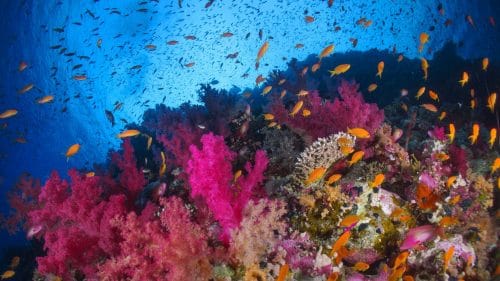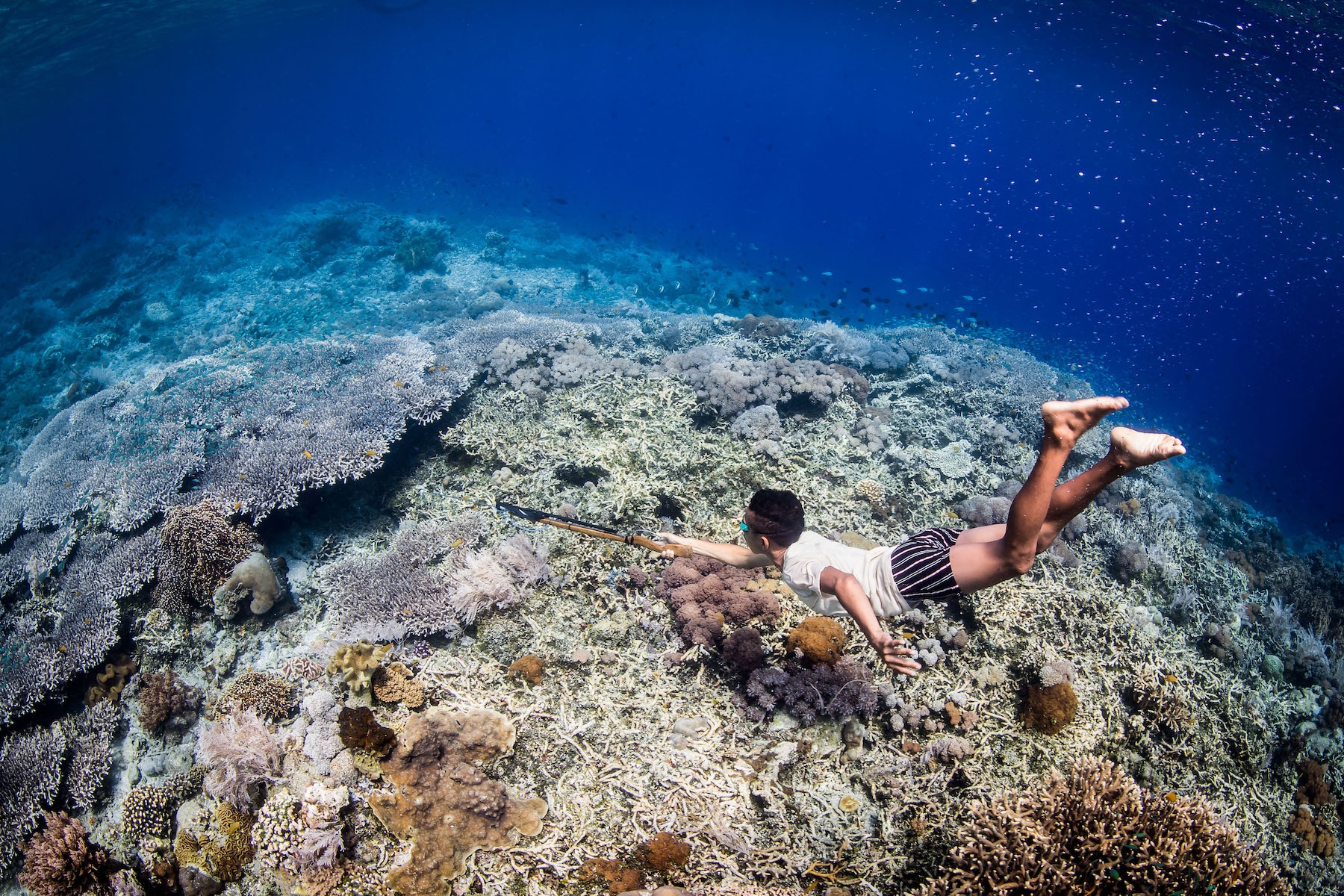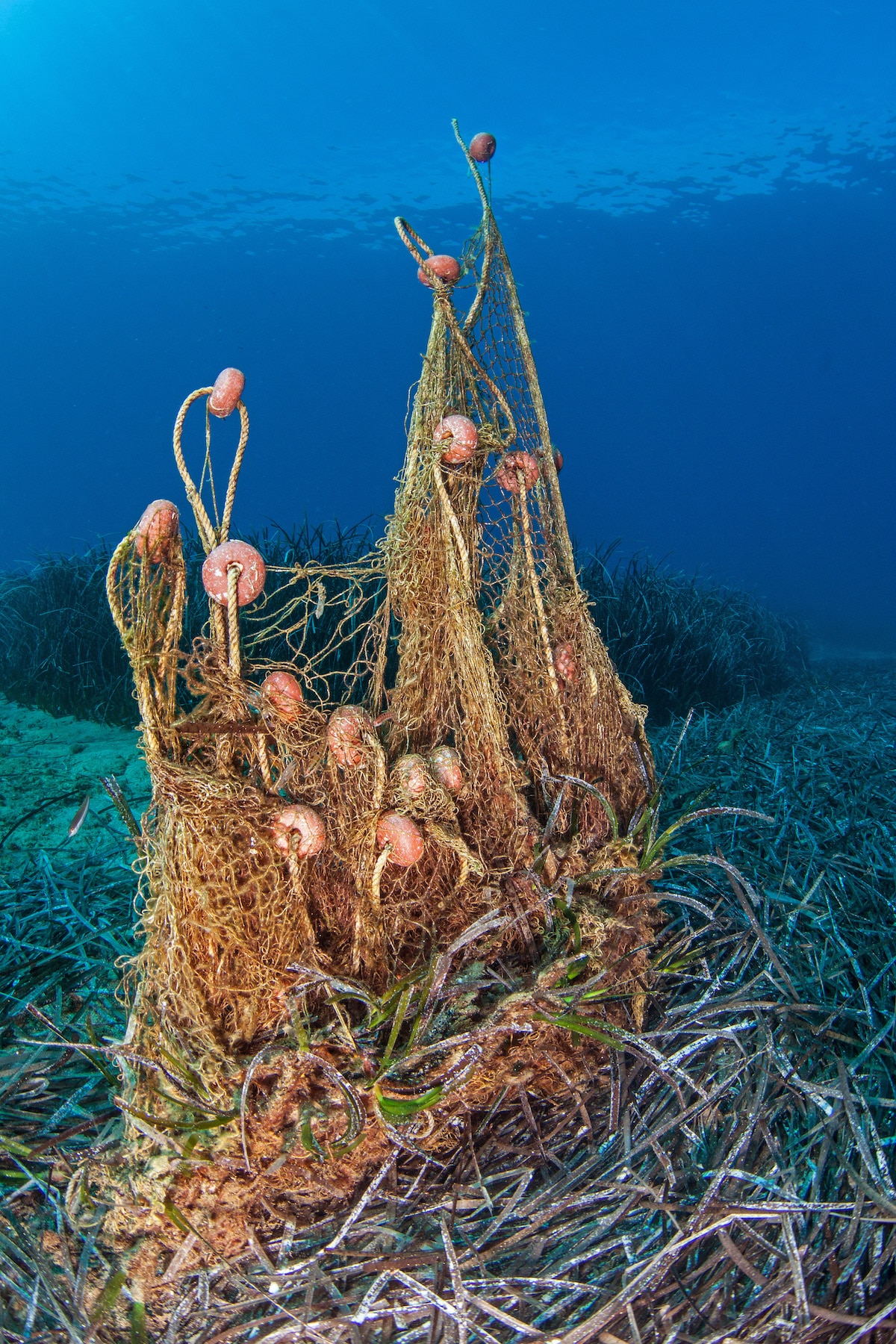What is Ocean Biodiversity

The ocean is a vast body of saltwater that covers around 71% of the planet’s total surface, and is connected throughout the world. We usually split it into five primary ocean basins due to historical, cultural, and geographical factors: the Pacific, Atlantic, Indian, Arctic, and Southern Ocean basins.
The ocean holds about 97% of the world’s water and supports 90% of the planet’s biosphere. The ocean is also of vital importance for life on our planet, serving as a support system that helps to mitigate climate change, produce oxygen, and provide food and economic possibilities for humanity.
Only 5% of the ocean has been explored and documented by humans due to its size. The rest of it, particularly its deepest regions, is still undiscovered.
What is biodiversity?
The United Nations Convention on Biological Diversity defines biodiversity or biological diversity as:
“The variability among living organisms from all sources, including, inter alia [among other things], terrestrial, marine and other aquatic ecosystems and the ecological complexes of which they are part: this includes diversity within species, between species and of ecosystems.”
There are three levels of biodiversity in this definition:
- Organisms diversity refers to the diversity of species found in various habitats. This is the diversity of creatures and species populations, as well as how they interact.
- Genetic diversity refers to the variety of genes found within a species, as well as processes like mutations, gene exchanges, and genome dynamics that occur at the DNA level and result in evolution.
- Ecosystem diversity refers to a region’s genetic, biological, and ecosystem diversity. This refers to the variety of species interactions and their surroundings.
Biodiversity exists now as a result of billions of years of evolution, natural processes, and, more recently, human activities. The biodiversity of the Earth and the ocean was substantially larger before the arrival of Homo sapiens. Due to the exploitation of Earth’s resources and exponential population increase, human activity has had a huge impact on the planet and its life.
Why is biodiversity so important?
By fulfilling specific roles that are typically important to their ecosystems and often to human survival, all species are an integral part of their environment. Here are some of the functions that different species provide:
- Capturing and storing energy
- Producing and decomposing organic material
- Circulating water and nutrients
- Controlling erosion and pests
- Helping regulate climate and atmospheric gases
Removing species from ecosystems may remove these important functions, both on Earth and in the ocean. Thus, the greater the diversity of an ecosystem, the better it can maintain balance and productivity and withstand environmental stressors, which are now a big threat to our ocean.
Biodiversity is also important from an economic point of view, for humans and the wellbeing of communities that rely on the ocean for food and resources.

- Food resources
- Biomedical research: coral reefs are home to numerous species that could be used to research and create new medications and products to sustain human health and treat and cure disease.
- Tourism and recreation: Beaches, marine reserves, parks, ecotourism.
Biodiversity, of course, has intrinsic value. All forms of life on Earth and within the ocean have the right to exist beyond their economic, scientific, and ecological contributions and are part of our cultural and spiritual heritage. Human beings have an ethical responsibility to protect biodiversity and safeguard the wellbeing of the ocean.
How many species live in the Ocean?
The ocean contains an immense variety of life. So far, about 226,000 marine species have been identified and recorded. However, these are but a small fraction of the total: According to a study published online in Current Biology today and supervised by Ward Appeltans of the Intergovernmental Oceanographic Commission of UNESCO, the ocean may be home to 700,000 marine species, with likely not more than a million. The study’s findings are based on the World Register of Marine Species (WoRMS).
Whales, dolphins and fish are some well-known species that live in the ocean, but they only make up a tiny part of marine biodiversity. In fact, only two to three percent of all living organisms in the ocean are fish species. While many species remain unknown, researchers believe that the great majority of undiscovered species will be identified and described before the end of the century.
In the last decade, more marine species have been identified than ever before, with an average of 2,000 discoveries every year. In the ocean, the pace of new species discovery is still increasing, even if this is no longer the case on land. Greater taxonomic efforts, a growing number of researchers participating in describing new species, and new technology allowing them to access previously unknown places are all contributing to the momentum (including improved diving gear and remotely operated submersible vehicles).
Over 150 new species of marine fish are found every year. Experts estimate that characterising the 5,000 species of marine fish that are now unknown will take another 30 years. Even large organisms are continuously being discovered today; for example, 780 crab species, 29 lobster species, 286 shrimp species, and 1,565 fish species were discovered between 1999 and 2008. Researchers estimate that 2 to 8 additional cetacean species and roughly 10 new marine reptile species (such as sea snakes) remain to be discovered.
Unknown species, on the other hand, are disproportionately composed of macroinvertebrates, with tens of thousands of species of crustaceans, mollusks (snails), worms, and sponges still waiting to be discovered.
Threats to biodiversity
Because the rate of species loss is higher than it has ever been, many biologists believe we are in the midst of a mass extinction. Every year, between 17,000 and 100,000 species are thought to be wiped out. According to studies, one out of every eight plant species is in danger of extinction. Human action is responsible for the majority of these species extinctions, primarily habitat damage due to more land being developed for human use, and harmful fishing practices.
The destruction of rainforests, coral reefs, mangroves, and other rich habitats around the world has become a hot topic that conservation organisations and international legislation are addressing to try to reverse destructive trends and support sustainable resource management.
The following are some of the most basic challenges to biodiversity:
- Human population growth is out of proportion to natural resource availability.
- Heavy consumption and excessive exploitation of natural resources (deep sea mining, drilling, etc.)
- Lack of sufficient knowledge and understanding of species and ecosystems
- Destruction of ecosystems and habitats due to increased land use, overfishing, sea shipping and transportation
- Ocean and waterways pollution
- Global climate change
New international agreements, such as the Convention on Biological Diversity, are assisting nations in recognizing the importance of their natural resources now and in the future. The Convention was created during the 1992 Earth Summit in Rio de Janeiro, when world leaders agreed on a comprehensive approach for “sustainable development” that meets our needs while ensuring the Earth’s resources are preserved for future generations. As nations continue to expand economically, this pact established proper stewardship of these resources.
The Convention’s three main objectives are:
- Conservation of biological diversity
- Sustainable use of its components
- Fair and equitable sharing of the benefits from the use of genetic resources

Data about detriment of biodiversity
Global biological diversity in the oceans is quickly reducing due to fast variations in water temperature, salinity, and nutrient concentrations, as well as overfishing, habitat destruction, and the introduction of foreign species. There is little question that the disruptive forces are cumulative and will result in the extinction of more species. As a result, the previously diversified populations’ stabilising function will be reduced, potentially resulting in hazardous outcomes such as habitats that are unable to execute their ecosystem tasks or lose their resilience.
Here are a couple of examples of what happens in the ocean and how the threats we just described cause biodiversity loss and habitat change and destruction.
- Overfishing and fertiliser inputs are reducing the biological diversity of coral reefs, turning them into species-poor environments with only a few algae species dominating. Because there aren’t enough reef fish left to keep the corals clear of algae, new coral larvae have a hard time establishing themselves.
- Species-poor communities dominated by filamentous algae are displacing European bladderwrack forests. Filamentous algae are an unsuitable home for many species, including young fish. For one thing, they produce less oxygen, and they only store nutrients for a limited period of time since, unlike bladderwrack forests, they are short-lived and a favourite diet of gastropods and crustaceans. The filamentous algae and large phytoplankton blooms caused by greater nitrogen concentrations effectively block light from reaching the new bladderwrack seedlings, exacerbating the problem. As a result, their development is stifled. The extinction of a species that offers a key ecosystem structure, such as bladderwrack, changes environmental circumstances and therefore the habitat, to the detriment of other species. One key long-term effect is a further decline in biological variety, which will eventually prevent the ecosystem from performing its purpose.
References
https://www.marinebio.org/conservation/marine-conservation-biology/biodiversity/
https://worldoceanreview.com/en/wor-1/marine-ecosystem/biodiversity/
https://ocean-climate.org/en/awareness/the-decline-of-marine-biodiversity/
https://www.frontiersin.org/articles/10.3389/fmars.2016.00248/full



